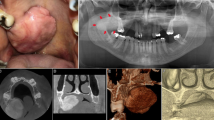Abstract
Surface osteosarcomas are a rare form of osteosarcomas accounting for around 3–6% of all osteosarcomas. Three major groups of surface osteosarcomas are parosteal, periosteal and the high grade surface osteosarcomas. Of these, the parosteal osteosarcoma is the most common. Parosteal and periosteal osteosarcomas are distinct clinical entities and it is important to identify the clinicoradiological differences between the two types. Surface osteosarcomas occur at a later age as compared to conventional osteosarcomas. The classical site is the lower end of the femur followed by the upper end of the tibia and upper end of humerus, in that order. The periosteal variant affects the tibia more commonly than the parosteal variety. Neo-adjuvant chemotherapy is the standard of care for high grade surface osteosarcomas. Parosteal osteosarcomas, being low grade lesions, can be treated by upfront wide excision without adjuvant systemic therapy. Controversy prevails over the need for chemotherapy in periosteal osteosarcomas, which are intermediate grade lesions.
Similar content being viewed by others
References
Sinovic JF, Bridge JA, Neff JR. Ring chromosome in parosteal osteosarcoma. Clinical and diagnostic significance. Ring chromosome in parosteal osteosarcoma 1992;62:50–2.
Bertoni F, Bacchini P, Staals EL, Davidovitz P. Dedifferentiated parosteal osteosarcoma: The experience of the Rizzoli Institute. Cancer 2005;103:2373–82.
Sheth DS, Yasko AW, Raymond AK, Ayala AG, Carrasco CH, Benjamin RS, et al. Conventional and dedifferentiated parosteal osteosarcoma. Diagnosis, treatment, and outcome. Conventional and dedifferentiated parosteal osteosarcoma 1996;78:2136–45.
Wold LE, Unni KK, Beabout JW, Sim FH, Dahlin DC. Dedifferentiated parosteal osteosarcoma. J Bone Joint Surg Am 1984;66:53–9.
Grimer RJ, Bielack S, Flege S, Cannon SR, Foleras G, Andreeff I, et al. Periosteal osteosarcoma: A European review of outcome. Eur J Cancer 2005;41:2806–11.
Okada K, Frassica FJ, Sim FH, Beabout JW, Bond JR, Unni KK. Parosteal osteosarcoma. A clinicopathological study. Parosteal osteosarcoma 1994;76:366–78.
Song WS, Jeon DG, Kong CB, Cho WH, Lee SY. Outcome of reexcision for intralesionally treated parosteal osteosarcoma. J Surg Oncol 2011;103:264–8.
Klein MJ, Siegal GP. Osteosarcoma: Anatomic and histologic variants. Am J Clin Pathol 2006;125:555–81.
Fletcher C, Unni KK, Mertens F. Pathology and Genetics of Tumors of Soft Tissue and Bone. IARC Press. Lyon, 2002.
Szymanska J, Mandahl N, Mertens F, Tarkkanen M, Karaharju E, Knuutila S. Ring chromosomes in parosteal osteosarcoma contain sequences from 12q13-15: A combined cytogenetic and comparative genomic hybridization study. Genes Chromosomes Cancer 1996;16:31–4.
Noble-Topham SE, Burrow SR, Eppert K, Kandel RA, Meltzer PS, Bell RS, et al. SAS is amplified predominantly in surface osteosarcoma. J Orthop Res 1996;14:700–5.
Wunder JS, Eppert K, Burrow SR, Gokgoz N, Bell RS, Andrulis IL. Co-amplification and overexpression of CDK4, SAS and MDM2 occurs frequently in human parosteal osteosarcomas. Oncogene 1999;18:783–8.
Song WS, Jeon D-G, Cho WH, Kong CB, Cho SH, Lee KR, et al. Clinical outcome of parosteal osteosarcoma. J Korean Bone Joint Tumor Soc 2013;19:20–7.
Zaikova O, Grimer RJ, Kindblom LG, Abudu AT, Tillman RM, Jeys L, et al. Parosteal osteosarcoma: Risk factors for local recurrence and death. J Bone Joint Surg Br 2011;93-B Suppl I:78.
Campanacci M, Picci P, Gherlinzoni F, Guerra A, Bertoni F, Neff JR. Parosteal osteosarcoma. J Bone Joint Surg Br 1984;66:313–21.
Johnson JS, Mayerson JL. Primary dedifferentiated parosteal osteosarcoma in a 21-year-old man. Am J Orthop (Belle Mead NJ) 2011;40:E182–5.
Campanacci M, Capanna R, Stilli S. Posterior hemiresection of the distal femur in parosteal osteosarcoma. Ital J Orthop Traumatol 1982;8:23–8.
Liu T, Liu ZY, Zhang Q, Zhang XS. Hemicortical resection and reconstruction using pasteurised autograft for parosteal osteosarcoma of the distal femur. Bone Joint J 2013;95-B:1275–9.
Kumar A, Khan SA, Sampath Kumar V, Sharma MC. Bizarre parosteal osteochondromatous proliferation (Nora’s lesion) of phalanx in a child. BMJ Case Rep 2014;2014:pii: bcr2013201714.
Murphey MD, Jelinek JS, Temple HT, Flemming DJ, Gannon FH. Imaging of periosteal osteosarcoma: Radiologic-pathologic comparison. Radiology 2004;233:129–38.
Unni KK, Dahlin DC, Beabout JW. Periosteal osteogenic sarcoma. Cancer 1976;37:2476–85.
Cesari M, Alberghini M, Vanel D, Palmerini E, Staals EL, Longhi A, et al. Periosteal osteosarcoma: A single-institution experience. Cancer 2011;117:1731–5.
Revell MP, Deshmukh N, Grimer RJ, Carter SR, Tillman RM. Periosteal osteosarcoma: A review of 17 cases with mean followup of 52 months. Sarcoma 2002;6:123–30.
Bertoni F, Boriani S, Laus M, Campanacci M. Periosteal chondrosarcoma and periosteal osteosarcoma. Two distinct entities. Periosteal chondrosarcoma and periosteal osteosarcoma 1982;64:370–6.
Staals EL, Bacchini P, Bertoni F. High-grade surface osteosarcoma: A review of 25 cases from the Rizzoli Institute. Cancer 2008;112:1592–9.
Okada K, Unni KK, Swee RG, Sim FH. High grade surface osteosarcoma: A clinicopathologic study of 46 cases. Cancer 1999;85:1044–54.
McClure J, Mangham DC. Surface tumours of bone. Diagn Histopathol 2012;18:139–48.
Author information
Authors and Affiliations
Corresponding author
Rights and permissions
About this article
Cite this article
Kumar, V.S., Barwar, N. & Khan, S.A. Surface osteosarcomas: Diagnosis, treatment and outcome. IJOO 48, 255–261 (2014). https://doi.org/10.4103/0019-5413.132503
Published:
Issue Date:
DOI: https://doi.org/10.4103/0019-5413.132503




